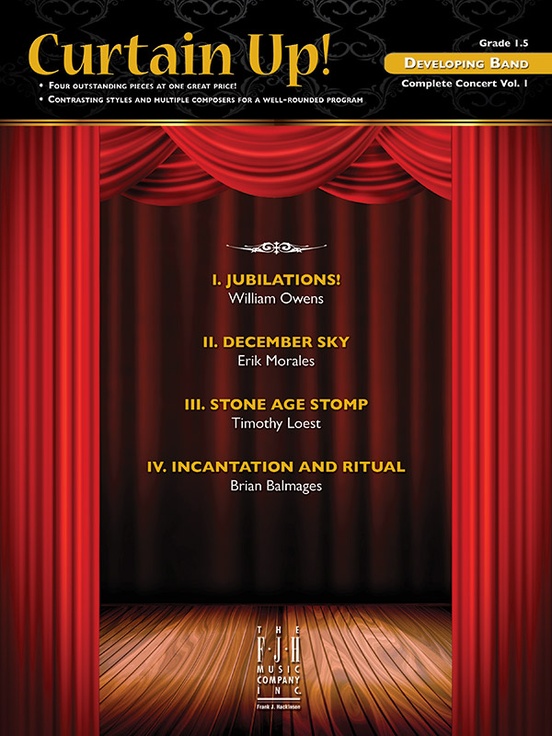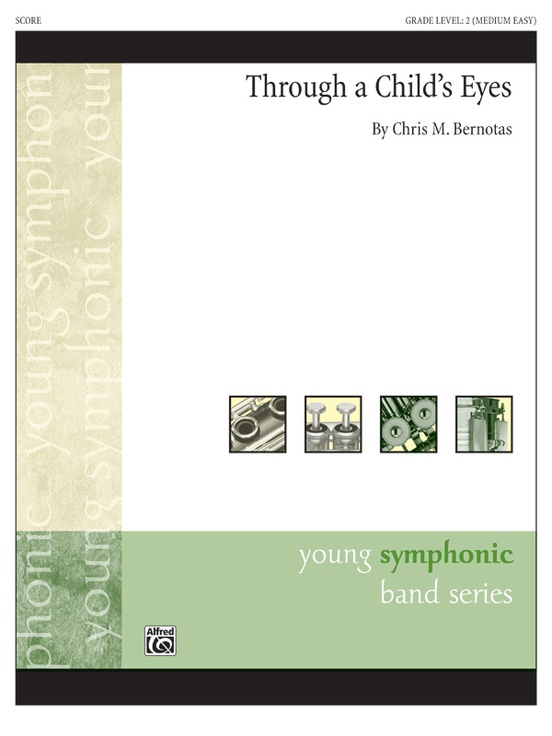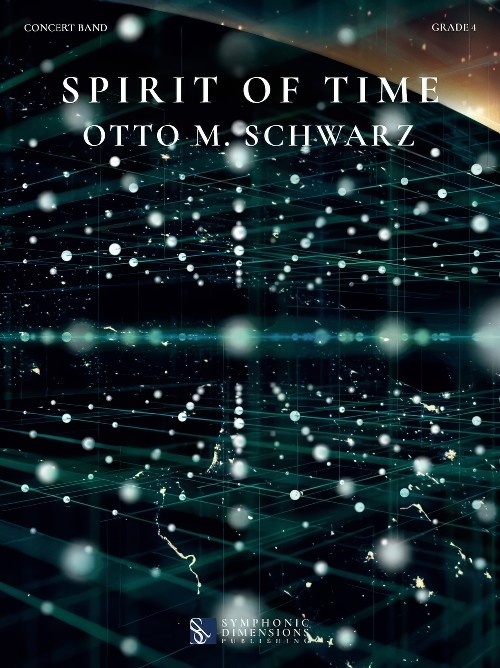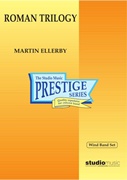Results
-
 £56.50
£56.50Pony Express - Chris M. Bernotas
reminds us of a time when the fastest way to deliver a message was on horseback, riding across the plains, mountains and desert. This piece has a slight "off-beat" gallop for the horseback ride and a lyrical section that is reminiscent of looking out over the vast spaciousness of the plains . . . and then we are back on the mission to deliver the mail and on to a most enjoyable finish! This title is available in MakeMusic Cloud.
Estimated dispatch 3-5 working days
-
 £119.00
£119.00Curtain Up! - Brian Balmages, Timothy Loest, Erik Morales, William Owens
For directors on a budget, we are pleased to offer this exciting collection of four pieces at one low price. Designed to work well as a full concert program, these pieces represent a variety of styles and composers for a well-balanced program! Titles include: (William Owens); (Erik Morales); (Timothy Loest); and (Brian Balmages).
Estimated dispatch 3-5 working days
-
 £52.95
£52.95Through a Child's Eyes - Chris M. Bernotas
is a composition with reflection on the innocence of a child, the discovery of the world around them and the peacefulness of a sleeping baby. After the somewhat bold introduction, the first theme brings a simple sense of comfort. The trumpets then stand proudly with a feeling of strength and confidence. After a climax we are led to a slightly contemplative section. The ending is filled with a recapitulation of the main theme accompanied with the music box. Rest and comfort come through with the sounding of the final chord. This title is available in MakeMusic Cloud.
Estimated dispatch 3-5 working days
-
 £104.00
£104.00Judgement Day - Peter Knockaert
The last decades we humans have witnessed a significant number of disturbing developments. If we look at the direct and persistent destructive influence of humans on nature: air and water quality are reducing, soils are depleting, crops are short of pollinators, coasts are less protected from storms, deforestation, the degradation of land, loss of biodiversity and pollution.In stark contrast we find the intelligence and boundless creativity of humans: what about all the high technological advancements? What lies ahead in the realm of Artificial Intelligence? Will we let machines make human decisions? What ethical issues arise there?This composition reflects the desperation and urgency of the human need for action. The music draws inspiration from the brutal natural forces that ravage our world as a direct consequence of human failure and selfishness.Are we heading towards a 'Judgment Day'? Or will humanity find a way to reverse negative trends towards a more livable, peaceful, and joyful environment for humans, animals, and nature?To underscore this message, composer Peter Knockaert opted for a highly classical idiom that has been used by many composers in classical music: the 'Dies Irae'. Traditionally, the Dies Irae is the third part of a requiem (funeral mass). The text used in 'Judgment Day' (for optional choir) is coming from the original Latin text.
Estimated dispatch 7-14 working days
-
 £144.99
£144.99Festa Paesana - Jacob de Haan
Lunteren, a village on the Veluwe (a wooded region in the Netherlands), sets the scene annually for a village festival dominated by folklore. Festa Paesana (Italian for village festival) is set to music by several folkloric sketches. The theme in Festa Paesana is partly based on a Dutch anthem (Wien Neerlands bloed); when other lyrics are used it is also known as the Lunteren anthem.The work begins with a festive introduction, completed by chimes and drums, in which pieces of the Lunteren anthem are heard. The music then transitions to represent a horse auction. We hear horses run their first rounds in the auction ring while being whipped. The following theme is partly basedon the anthem. The tension of the traditional auction is amplified by an ever-increasing cadence, reaching its climax when the word ?Sold!? is shouted. The night ends with a majestic variation on the Lunteren anthem.The next morning, when the tower clock hits seven times, the village is awaked by the reveille of the heralds. In a fugatic version of the anthem, we can hear the village slowly come to life. This evolves with the chiming of all towers in the village; the celebration can begin. Carriages drawn by horses rumble through the village and thus, it is easy to hear when a horse hesitates or runs amuck. A traditional folk dance group then dances a whirling waltz while the audience shares their pleasure. Musicians march along the scene and take over the waltz theme in their march. Until deep in the night, the musicians are still heard playing in the streets. Meanwhile, we hear the anthem theme being played in a choral variation (in minor). The first time it is played quietly, as a preparation for Sunday. Then it is played in a celebrating way, enabling the devout village residents to remember the past pleasant celebration with satisfaction.
Estimated dispatch 7-14 working days
-
 £159.99
£159.99Spirit of Time (Concert Band - Score and Parts) - Schwarz, Otto M.
Zeitgeist; transformations; a departure for new shores... these are buzzwords we often encounter nowadays. Above all in this digital age, it is essential that we face changes positively and that we make the very best of them. Music is emotion! Otto M. Schwarz begins many of his lectures with this phrase, and this is exactly what we feel in this new concert work. Rapid, and full of energy, is the leap into a new chapter, wonderful opportunities are waiting to be discovered in uncharted lands. But change is not only loud and momentous. The creative power of the future lies dormant in the inventive spirit of the individual, quietly, thoughtfully, silently and alone! The final sequence of this work is all about good vibes: it lights the way to a positive future and stands for the dawn of a new era!Duration: 9.45
Estimated dispatch 7-14 working days
-
£144.99
Festa Paesana Wind Band Set (Score & Parts)
Lunteren, a village on the Veluwe (a wooded region in the Netherlands), sets the scene annually for a village festival dominated by folklore. Festa Paesana (Italian for village festival) is set to music by several folkloric sketches. The theme in Festa Paesana is partly based on a Dutch anthem (Wien Neerlands bloed); when other lyrics are used it is also known as the Lunteren anthem.The work begins with a festive introduction, completed by chimes and drums, in which pieces of the Lunteren anthem are heard. The music then transitions to represent a horse auction. We hear horses run their first rounds in the auction ring while being whipped. The following theme is partly based on the anthem. The tension of the traditional auction is amplified by an ever-increasing cadence, reaching its climax when the word ?Sold!? is shouted. The night ends with a majestic variation on the Lunteren anthem.The next morning, when the tower clock hits seven times, the village is awaked by the reveille of the heralds. In a fugatic version of the anthem, we can hear the village slowly come to life. This evolves with the chiming of all towers in the village; the celebration can begin. Carriages drawn by horses rumble through the village and thus, it is easy to hear when a horse hesitates or runs amuck. A traditional folk dance group then dances a whirling waltz while the audience shares their pleasure. Musicians march along the scene and take over the waltz theme in their march. Until deep in the night, the musicians are still heard playing in the streets. Meanwhile, we hear the anthem theme being played in a choral variation (in minor). The first time it is played quietly, as a preparation for Sunday. Then it is played in a celebrating way, enabling the devout village residents to remember the past pleasant celebration with satisfaction. 0:08:10
Estimated dispatch 7-14 working days
-
 £274.99
£274.99Symphony No. 2: States Of Mind, Opus 87 - Teo Aparicio-Barberán
I- Logos (reason)II- Pathos (emotion)III- Ethos (credibility)The ancient Greeks believed that music shaped the character of man. In Egyptian temples, music was an essential part of the magical rites to alter the course of nature or to treat illness.And today we know that sound can actually alter matter. The secret of music lies in harmony and mathematics, as many great musicians and experts have always known.One of the most important qualities of music is that it enables the listener to focushis attention inwards instead of on what is around him. It is indisputable that music can inspire emotion. Music leads us into a universe of emotions that are difficult to put into words. In short, music reaches into corners of our soul and thoughtsthat words cannot reach and makes it possible to more clearly describe these different States of mind.The composer of this symphony also believes that each "musical argument" must be constructed so that it will induce the desired reaction in thelistener.Music: more than wordsIn recent times, most orchestral symphonies have been based on a story, a text or something similar so that their composition must be structured accordingly.The intention of this work by Teo Aparicio-Barbern is quitedifferent. The composer describes the three elements of the argument as the only formal structure of the work. Since certain philosophers in world history were able to subdivide grammatical argument, why shouldnt that also be possible for the musicalargument?Since ancient times the power of the spoken word has captivated mankind. How can an argument move people and mobilise the masses? Where does the power of words come from today? The answer lays not so much in what people say but in how theysay it.Rhetoric is one of the oldest humanist disciplines in Western civilisation. Aristotle, in the 4th century BC, called it the art of persuasion. Indeed, the terms rhetoric and persuasion are mutually interchangeable.More than 2000 years agoAristotle structured his rhetoric according to the following three elements: the logos, the pathos and the ethos.Logos (words, reason) is the reasoning that gives freedom to the structure of the text by expressing what one wishes to say usingspecialist terms. With logos we create arguments to receive public approval and to defend our ideas.Pathos, the second element, refers to the effective use of public psychology. Pathos can be considered as the capacity to induce the desired emotionalresponse in the public, by creating an emotional connection with the public so that they accept our message.The third element, ethos (credibility), refers to the character of the speaker and is perhaps the most important of the three elements.Aristotle based his concept of ethos upon his belief that truth and justice will always have the upper hand over anger. He believed that what was true and good was easier to prove and was more persuasive.This second orchestral symphony from thecomposer from Enguera follows these three parameters of the argument according to Aristotle. Each movement tries to summon a different state of mind in the listener so that the message itself can be better understood and appreciated. Apart from thesethree general concepts the music is only structured, as Claude Debussy would say, in a "formative way".The first movement, logos, is based on a scherzo melody that undergoes various changes in rhythm and harmony. The arguments are presented by meansof conventional techniques of composition. The second movement, pathos, is characterised by suggestions of sound. It is subdivided into two large parts. The first part is based on a five seven sequence with five sounds that are repeated in differentenvironments, structures and dynamics. The second part, which is largely tonal, brings out more directly the emotional overtones that each argument must have. The third movement, ethos, is a faithful rendition of the composers personality. In thislast part, clear rhythmic sequences stand out, there are large dynamic contrasts and lots of tone variation. In addition, and this is quite in keeping with the composers earlier work, the harmony in States of Mind is handled in a manner that is bothoriginal and efficient, as a result of which Aparicio-Barberns message is well understood by the listener.This second symphony by Teo Aparicio-Barbern is devoted to "my dear Henrie Adams, a guiding light in this eternally dark musical world. Thankyou for everything."
Estimated dispatch 7-14 working days
-
 £164.95
£164.95Roman Trilogy (Prestige Concert Band - Score and Parts) - Ellerby, Martin
This work falls into three movements, all concerned with the subject of the Italian capital city of Rome, rather like previous tributes to other European citites in Paris Sketches, Venetian Spells and The Cries of London. The emphasis is on atmosphere and drama, be they respectful or joyful! It is acknowledged that Ottorino Respighi has influenced this work though his own eternal Rome tributes are not challenged here, rather saluted and celebrated.The three movements are: 1. Collosea di Romaan evergrowing march mood, builds in intensity and density as we approach the mighty Colosseum, the amphitehatre of Classical Rome, where deadly spectacles were once played out. We should not forget that countless thousands died here whilst even more laughed in the name of entertainment: their memory is reflected in the coda. In its unique way this icon of Rome is one of the most tragic historical places.2. Capella Sistinathe Sistine Chapel of the Vatican City is observed in a series of chorales and interludes. The visitor can look 360o around and be presented with a series of Biblical representations and commentaries. The music attempts to reflect these contrasting panels whilst ultimately bowing to the glory of this magnificent artistic creation. The coda is enigmatic, inconclusive - a single viewing cannot reveal all the mysteries and beauties within. 3. Fonatani di Trevitime for laughter and fun! The Trevi Fountain is one of Rome's finest and visually overboard locations! This is indicated as a Burletta: 'a la dolce vita' which means 'the sweet life'. This burletta (meaning 'little joke') makes use of tarantella and saltarello rhythms and features a pair of tambourines which are associated with these forms. La Dolce Vita was also a film by the renowned Italian director Federico Fellini featuring a memorable scene in the Trevi with a wet Enita Ekberg: something modern day visitors are discouraged from emulating!Duration: 11:15Recorded on Polyphonic QPRM161D ROMAN TRILOGY (TheRoyal Northern College of Music Wind Orchestra).
Estimated dispatch 7-14 working days
-
 £37.95
£37.95Roman Trilogy (Prestige Concert Band - Score only) - Ellerby, Martin
This work falls into three movements, all concerned with the subject of the Italian capital city of Rome, rather like previous tributes to other European citites in Paris Sketches, Venetian Spells and The Cries of London. The emphasis is on atmosphere and drama, be they respectful or joyful! It is acknowledged that Ottorino Respighi has influenced this work though his own eternal Rome tributes are not challenged here, rather saluted and celebrated.The three movements are: 1. Collosea di Romaan evergrowing march mood, builds in intensity and density as we approach the mighty Colosseum, the amphitehatre of Classical Rome, where deadly spectacles were once played out. We should not forget that countless thousands died here whilst even more laughed in the name of entertainment: their memory is reflected in the coda. In its unique way this icon of Rome is one of the most tragic historical places.2. Capella Sistinathe Sistine Chapel of the Vatican City is observed in a series of chorales and interludes. The visitor can look 360o around and be presented with a series of Biblical representations and commentaries. The music attempts to reflect these contrasting panels whilst ultimately bowing to the glory of this magnificent artistic creation. The coda is enigmatic, inconclusive - a single viewing cannot reveal all the mysteries and beauties within. 3. Fonatani di Trevitime for laughter and fun! The Trevi Fountain is one of Rome's finest and visually overboard locations! This is indicated as a Burletta: 'a la dolce vita' which means 'the sweet life'. This burletta (meaning 'little joke') makes use of tarantella and saltarello rhythms and features a pair of tambourines which are associated with these forms. La Dolce Vita was also a film by the renowned Italian director Federico Fellini featuring a memorable scene in the Trevi with a wet Enita Ekberg: something modern day visitors are discouraged from emulating!Duration: 11:15Recorded on Polyphonic QPRM161D ROMAN TRILOGY (TheRoyal Northern College of Music Wind Orchestra)
Estimated dispatch 7-14 working days
